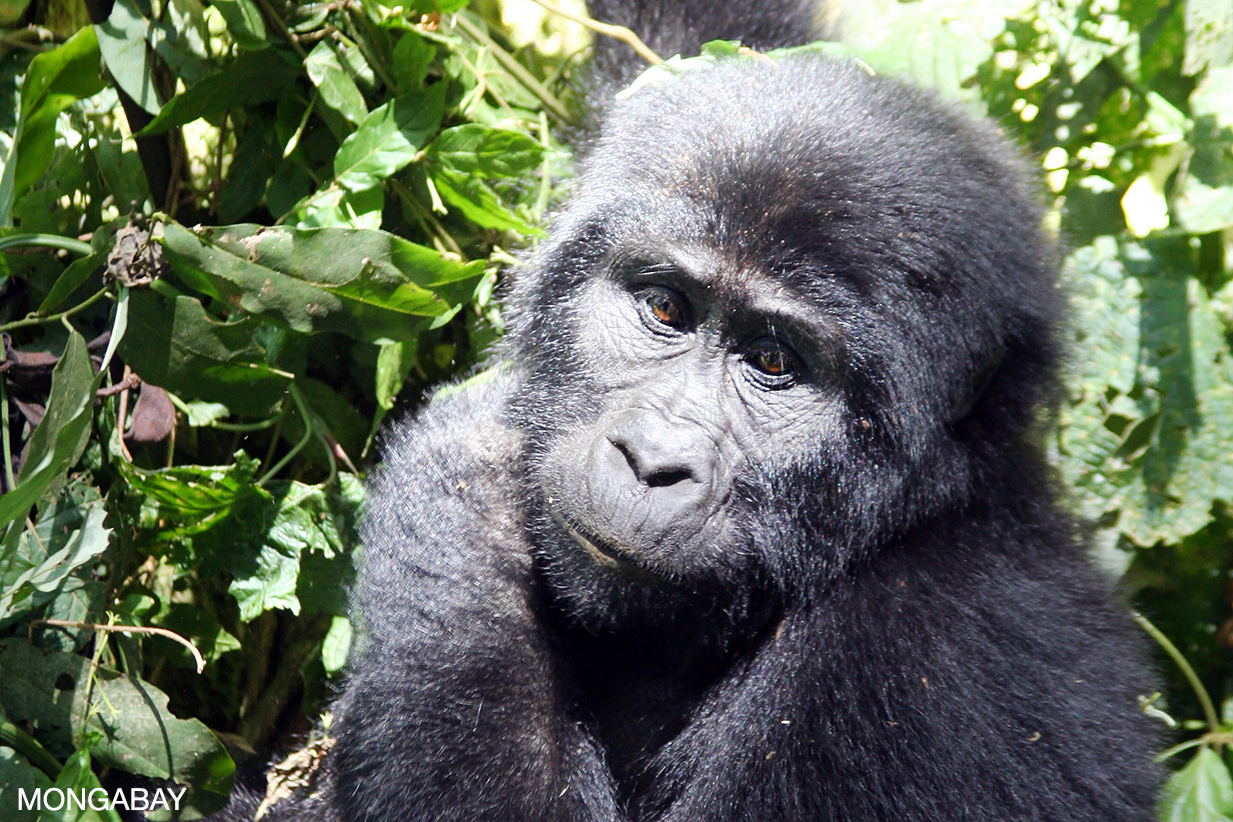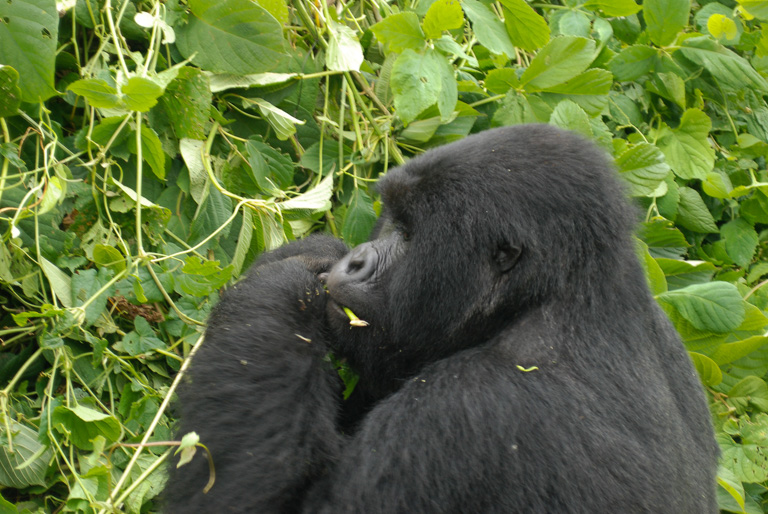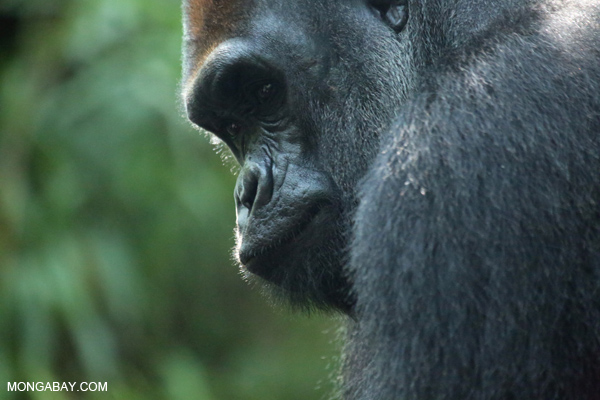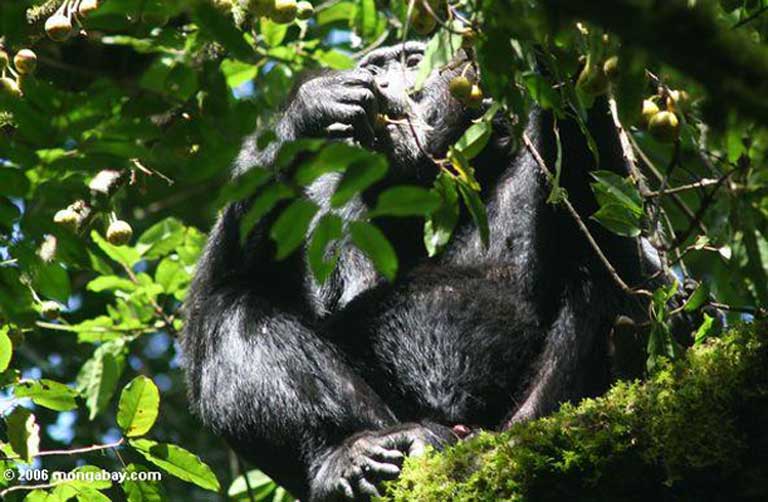- With flights grounded, parks closed and countries on lockdown, COVID-19 has dealt a major blow to great ape-focused ecotourism operations in Africa and Asia.
- Many conservation activities rely directly on revenue from tourism, and the money tourism brings in also provides a financial incentive for governments and local communities to protect wildlife.
- If lockdowns persist for months, the consequences could be devastating for fragile ape populations and the communities that surround them.
- The situation has re-emphasized the need for conservation groups to diversify their fundraising strategies, experts say.
In the 23 years since founding Volcanoes Safaris, Praveen Moman has weathered a range of crises in the region around Rwanda and Uganda: Ebola outbreaks, economic strife, kidnappings, political unrest. But the COVID-19 pandemic, he says, is “off the Richter scale.”
During previous crises, gorilla and chimpanzee trekking companies like his could fall back on their expertise to encourage travelers to visit. “You know the geography, you know the topography, you know the politics,” Moman says.
But the COVID-19 pandemic has grounded the vast majority of international flights. Many countries, like Uganda and Rwanda, are on lockdown, and tourism has come to a standstill across the world. The situation is unprecedented. “9/11 was a major global event,” Moman says. “But in the end, the world started again within a few weeks of it.”
Amid fears that resident apes could be susceptible to COVID-19, parks in Uganda and Rwanda closed to tourists, and Moman shuttered his company’s four lodges until at least June. He sent most of his staff home, providing “financial assistance as appropriate” and food in some cases. But with tourism on hold for the foreseeable future, these funds won’t last forever.
Moman’s story is one that’s currently playing out at all great ape tourism sites. The lack of visitors could have potentially devastating consequences for conservation operations that rely on tourism income. That revenue also provides financial incentives for governments and citizens to protect the wildlife around their communities.

Mountain gorilla tourism is arguably the most effective example of the positive impact wildlife tourism can have on conservation. In 1981, the mountain gorillas (Gorilla beringei beringei) of the Virunga region of East Africa had dwindled to around 250. By 2010, the population had nearly doubled. Today, the total population (including the isolated Bwindi population) is more than 1,000 and the species’ conservation status was downgraded from critically endangered to endangered in 2018.
Tourism in parks such as Volcanoes National Park in Rwanda, Bwindi Impenetrable National Park in Uganda and Virunga National Park in the Democratic Republic of Congo (DRC) has provided a convincing financial incentive for governments and local communities to protect the mountain gorillas and their habitat. The sector contributes 60% of the Uganda Wildlife Authority’s revenue. Communities in Uganda and Rwanda also receive a percentage of tourism revenue, along with employment and entrepreneurial opportunities associated with tourism.
But as that income evaporates, there’s a high chance desperate communities around national parks will turn to poaching and logging — not just in mountain gorilla territory, but around every great ape site where tourism is the main income stream.
What will happen in the immediate future with the tourism industry grounded? And longer term, in light of a global recession and the likelihood that available resources will be diverted to other causes, how will the possibility of reduced conservation funding affect apes?

Tourism hiatus
“The situation is different at every single site,” says Johannes Refisch, coordinator of the United Nations Great Apes Survival Partnership program (GRASP). “I’m sure any site would give priority to paying staff, but are there sufficient reserves to pay staff for one month or two months or three months? I don’t know.”
The African parks in which great ape tourism exists — all mountain gorilla sites, plus national parks such as Nyungwe in Rwanda, Odzala-Kokoua in the Republic of Congo and Loango in Gabon — were closed fairly quickly, spurred by advice regarding primates’ susceptibility to the coronavirus. A notice from the IUCN’s specialist groups on wildlife health and on primates said: “At this point, it is safest to assume that great apes are susceptible to SARS CoV-2 infection.” They advised keeping contact with great apes to an absolute minimum. That means tourism will be extremely risky until the pandemic is fully controlled.
Moman says he considers the speedy response of the Ugandan and Rwandas governments in closing the parks an encouraging thing: “There wasn’t a feeling of ‘we have to keep these parks open and milk it as much as we can,’” he says.

Poaching and health
Mountain gorillas are particularly at risk not only because of their precarious population size, but because they exist in such a narrow range, restricted to the Virunga Mountains and Bwindi Impenetrable National Park. That’s only around 800 square kilometers (300 square miles) and in one of sub-Saharan Africa’s most densely populated rural areas.
“We’re worried that the poaching is going to go up,” says Gladys Kalema-Zikusoka, a veterinarian and founder of the Ugandan nonprofit Conservation Through Public Health (CTPH). Targeted poaching of gorillas is not a primary concern at this stage, but they can still be fatally injured by snares laid for smaller animals. Even apes that survive now face an added risk: coming in contact with hunters means a risk of being infected with COVID-19.
The absence of tourists on daily treks and the rangers who monitor the gorillas will make poaching in the national parks easier. It also makes it more likely. Kalema-Zikusoka says people, driven primarily by the need to feed themselves in the absence of tourism income, will take advantage of the sudden lack of footfall in the forests.
“The rangers [in Uganda] have been told to be much more vigilant,” she says. “They still have to visit the gorillas whether or not there are tourists … they have to reach them, they have to make sure they’re fine, they have to stay there for some time.”
Moman says he’s hopeful that many people who live around gorilla parks in Rwanda and Uganda will resist poaching and encroachment for now, protecting a “win-win” tourism model. Over the past 20 years, schools, clinics and roads have been built on the back of gorilla tourism. “It might be small scale, it could be better and maybe not enough money gets through — but something is getting through,” he says.
Kalema-Zikusoka and her team have already been training rangers for new measures to protect the gorillas. Uganda and Rwanda have never enforced the wearing of protective face masks around gorillas, unlike most other great ape tourism operations across the continent. Instead, tourists are simply told not to trek if they feel unwell. This is far from foolproof and definitely won’t work with COVID-19, where many positive cases have been asymptomatic.
“Everyone has to wear a mask now,” Kalema-Zikusoka says. “Also because they [the rangers] may be protecting themselves from each other. And they have to take their temperature before they go in [to the park].”
The CTPH team is encouraging people to start farming again — something that many in the communities stopped doing in favor of tourism employment.
Other areas have less support. “I would say Central Africa is more at risk for various reasons,” Refisch says. “The areas that do not benefit from the big grants and entirely depend on income from tourism are most at risk. They have very little buffers.
“If it’s a site where a lot of the eco guards are from the surroundings and have a farm and can survive on [that], it’s probably fine,” he adds. “But that’s not the case in all areas.”

Asia: Weakening the conservation voice
For orangutans in Indonesia and Malaysia, the situation is different. “We have big problems in Indonesia, independent from the corona crisis,” Refisch says. “Indonesia has lost a lot of its forest, often converted into oil palm plantations. We do understand the need for development, but the expansion of plantations should be directed towards degraded lands instead of converting primary forest.”
Great ape tourism generates far less revenue in Asia than in Africa. An orangutan trek can cost less than $100 in total, whereas just the permit to see mountain gorillas in Rwanda is $1,500. A sudden downturn of tourism is going to impact Rwanda more than Indonesia, where the GDP is not so dependent on wildlife tourism.
Indonesia has a tough approach to opposition and criticism. Without ecotourism revenue to point to, NGOs may have an even harder time convincing the government to consider sustainable development alternatives, further weakening the conservation voice. The country has already taken steps to loosen environmental regulations during the COVID-19 pandemic.
Orangutan sanctuaries will struggle without tourism money. “You can stop operations, but you cannot stop feeding animals, and that costs a lot of money,” Refisch says. “They need income.”
This is true for sanctuaries globally, whether small chimpanzee sanctuaries in East Africa that rely on tourism revenue, or sites like Kinshasa’s Lola ya Bonobo, the world’s only bonobo rehabilitation sanctuary.

Alternative revenue streams
The COVID-19 pandemic is a harsh reminder that many areas may need to stop relying so heavily on tourism, with its sensitivity to local and global events. It pays to have other industries in motion — such as REDD+ projects, sustainable agriculture or eco-charcoal production — so that when tourism revenue stops flowing, rural communities have a buffer.
Kalema-Zikusoka points to a few positive examples.
Some people who used to rely on tourism revenue have been able to pivot to coronavirus-related industries. Ride 4 a Woman is a local microfinancing initiative, founded by Evelyn Habasa and her husband, Denis Rubalema. Their shop in Buhoma, just outside Bwindi in Uganda, was going to close when tourists stopped arriving, but instead the seamstresses have started sewing face masks for the park staff and, eventually, tourists.
“Obviously she [Habasa] can’t hire as many women, but at least she has some business,” Kalema-Zikusoka says. The CTPH team has discussed rolling out a soap-making business around Bwindi, too.
In 2015, CTPH established Gorilla Conservation Coffee. Farmers are paid above-market prices for coffee to reduce their dependency on the park for food and firewood, and a donation from each bag sold goes toward CTPH’s projects in community health and gorilla welfare. The coffee is sold domestically and internationally, with roasters in the U.S., Europe, New Zealand and South Africa.
“Revenue from Gorilla Conservation Coffee and other alternative livelihood projects versus tourism is roughly estimated at between 30% and 50% of what they could currently earn from tourism revenue,” Kalema-Zikusoka says.
“They’re harvesting right now,” she adds. Cargo planes are still flying, so they’re able to keep selling, as things stand.
Elsewhere, with the loss of tourism revenue and many people out of work, the poaching of rhinos, elephants and other high-value species will very likely increase. For many poachers, this will be out of sheer financial desperation.

NGO cash flow
The COVID-19 pandemic may also affect the funding on which great ape conservation organizations rely, as the world faces a deep financial recession. Available funds may be diverted to more human-focused causes. Tourism also finances some NGO work, and the absence of that revenue will now increase the reliance on other donors.
“We’re continuing the fundraising, but we’re changing what we say — we’re focusing more on the human side rather than the animal side,” Kalema-Zikusoka says. This means emphasizing efforts to train park staff, reduce human-wildlife conflict, and support community health teams so people remain healthy where gorillas range, she says. “If there’s a donor who understands what we’re trying to do, then they’ll give us funding.”
“We have to respond fast [and] convince our bilateral and multilateral funders,” Refisch says. “It takes 10 years to habituate a group of chimpanzees so that humans can visit them. It’s a lot of investment — we have invested in research, in park management. If you can’t respond to the crisis, there’s a high risk that we’ll lose it all.”
Many international governments will be unable to help immediately, given how much money they are pumping into their own economies. “[We should] also reach out to philanthropists and foundations — they’re often the ones who can respond fastest, because they don’t have the many layers the governments have,” Refisch says. “That’s something where I hope the UN can help.”
Primates receive a lot of high-profile attention that helps with fundraising, from Ellen DeGeneres, whose foundation is building a campus for the Dian Fossey Gorilla Fund in Rwanda, to big-name conservationists such as Jane Goodall. It’s possible this will help boost great ape causes in the coming months.
Refisch says he also aims to secure funding for a study of disease response when remote landscapes are opened for development. “We believe that there are diseases that migrate into the forest and infect wildlife and people, and they don’t have immunity. We usually start disease monitoring and disease prevention when it’s too late,” he says, citing Ebola and HIV as examples. Coronavirus, he notes, would probably never have reached many remote communities, but in a modern world with mass travel of goods and people, everyone is vulnerable.

Potentially devastating
Ultimately, the pandemic could be devastating for great ape populations, both directly and indirectly.
“The Bwindi gorilla population could be wiped out by a highly infectious disease like COVID-19,” Kalema-Zikusoka says, adding that it could easily spread between families when gorillas fight or transfer to another group.
“We need to set up emergency funding mechanisms — how to implement and how to make sure the money flows fast,” Refisch says. Without these funds, he says, there may be an increase in poaching, the live animal trade and encroachment, along with infrastructure breaking down and patrol cars not being maintained. “It’s a long list of things.”
“There is a risk that we will lose great apes when law enforcement operations are suspended,” Refisch says. “Great apes have long reproduction cycles and it takes a long time for populations to recover.”
FEEDBACK: Use this form to send a message to the author of this post. If you want to post a public comment, you can do that at the bottom of the page.